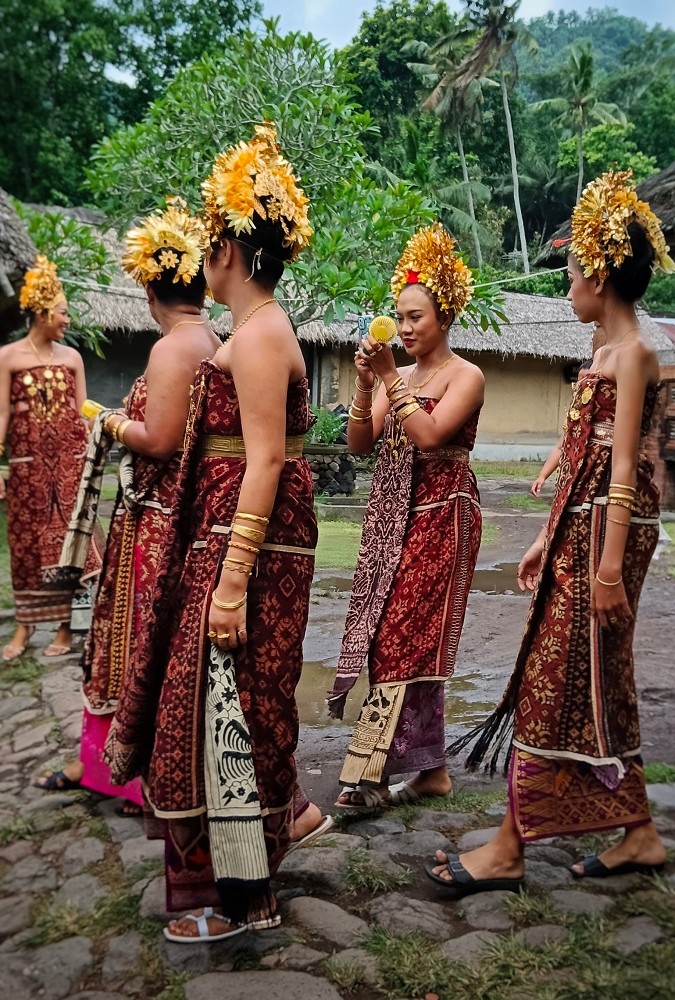
Kurniawati was sitting next to me under a roof covered in jaka fibers, while she was waiting to pick up the daha (unmarried women) for the coming-of-age ritual, part of Usaba Kasa. It was 10 in the morning, “The girls have been getting ready since the morning, while the boys are drinking. We are waiting for the right time to pick them up,” shares Kurniawati.
Usaba Kasa is the first month of the Tenganan Pegringsingan’s calendar where the ancestors, or sungsungan, were born. The people of Tenganan Pegringsingan honour them through dances and prayers performed in this Usaba Kasa, starting from the first full moon of the year, where the women cook rice together under the moonlight, to the dances performed by the daha and teruna on Hud Pang Nem, the last day of Usaba Kasa ceremony.
One of the dances that are performed a few times in this ritual is the Rejang dance. During Usaba Kasa, this dance is performed by the daha, who are adorned in gringsing textiles inherited from their mothers. As this dance is performed a few times, the role of textiles worn by women plays an essential role in determining the significance of the dance.
Gringsing itself is a textile that is considered to have protective power. The word gringsing is an acronym for gering, which means sick, and sing, which means no. When the words are combined together, the meaning becomes “against sickness’. “What we consider sick goes by the definition of sickness as in spirituality and nature that affects us as humans, the gods, our ancestors, and the nature of where we live in,” said I Wayan Yasa, who together with his wife, Ni Made Ariani Laksmi, set up a gringsing ikat production business, called Tunjung Biru.



With its immensely protective power, gringsing is used during rituals in Tenganan Pegringsingan village as both offerings and clothing, made using the double-ikat technique where the lusi or weft (crosswise threads) and pakan or warp (horizontal threads) are both wrapped and dyed individually, before precisely weaving them all together to create patterns in the finished piece of cloth. The threads are dyed in both Tenganan Pegringsingan and the nearby village, Bugbug, as the people of Tenganan Pegringsingan only dye in red and have taboos with indigo colour. The indigo colours create a dark blue colour, that when dyed many times or mixed with the red from morinda, becomes black. The sacred colours of Tenganan Pegringsingan are reflected in the colours of their gringsing; black, red, and yellow. The union of these three colours are called Tridatu, the colours that resemble the basic elements of life; black for water, red for fire, and yellow for air. In gringsing textiles, Tridatu are the only colours used in dyeing the threads as it becomes a manifestation of balance in life – the quintessence of having a life away from sickness.
One of the gringsing textiles worn by the dancers during Usaba Kasa is Gringsing Wayang Kebo. Gringsing Wayang Kebo is a sacred prestigious textile that consists of one full lubeng (stupa), placed between two half lubeng on each corner of the textile. Each lubeng is protected by a teledu (scorpion) in every direction. Teledu is a manifestation of protection and character of the people in Tenganan Pegringsingan village. It is considered a sacred animal that protects every gate, where spirits come and go through Tenganan, from north to south and west to east. The motifs between each lubeng are decorated by intricate human-like figures that resemble wayang kulit or leather puppets. While the word kebo resembles buffalo, an animal that is considered holy and sacred in Tenganan Pegringsingan. “Gringsing Wayang Kebo is a textile that you have to see quietly and attentively from a distance because of the intricacy of the weaving”, suggested I Wayan Yasa. From a good distance, viewers can see the figures on the textiles that sit down in between the lubeng. However, there is no resemblance of a buffalo on the textile. As the buffalo is a hidden meaning of holy figures that protect the wearers and the village from the evil spirit.

In Usaba Kasa, Rejang and Abuang dances are performed by Daha or unmarried women from the second day to the fifth day of the ritual. On the second day of Usaba Kasa or Hud Pindo, unmarried women wear Gringsing Wayang Kebo over their shoulder as a dancing scarf that they call Nyandang Kebo during Rejang Petemu Kaja. This dance is performed near sacred places like temples or Bale Agung by unmarried women as they resemble Widyadari who guided Ida Bhatara when he carried out the melasti cleansing ceremony.
On the last day of the Usaba Kasa celebration, the daha were picked up by their mothers before walking to the sacred place to dance Rejang and Abuang. They were adorned in their mothers’ gold jewellery, manicured and dolled up. “I remember the first time I performed Rejang. I was very proud of myself, my mother as well. I felt like I was chosen by the spirits up there”, shares Ni Made Ariani Laksmi, reminiscing her younger days.


